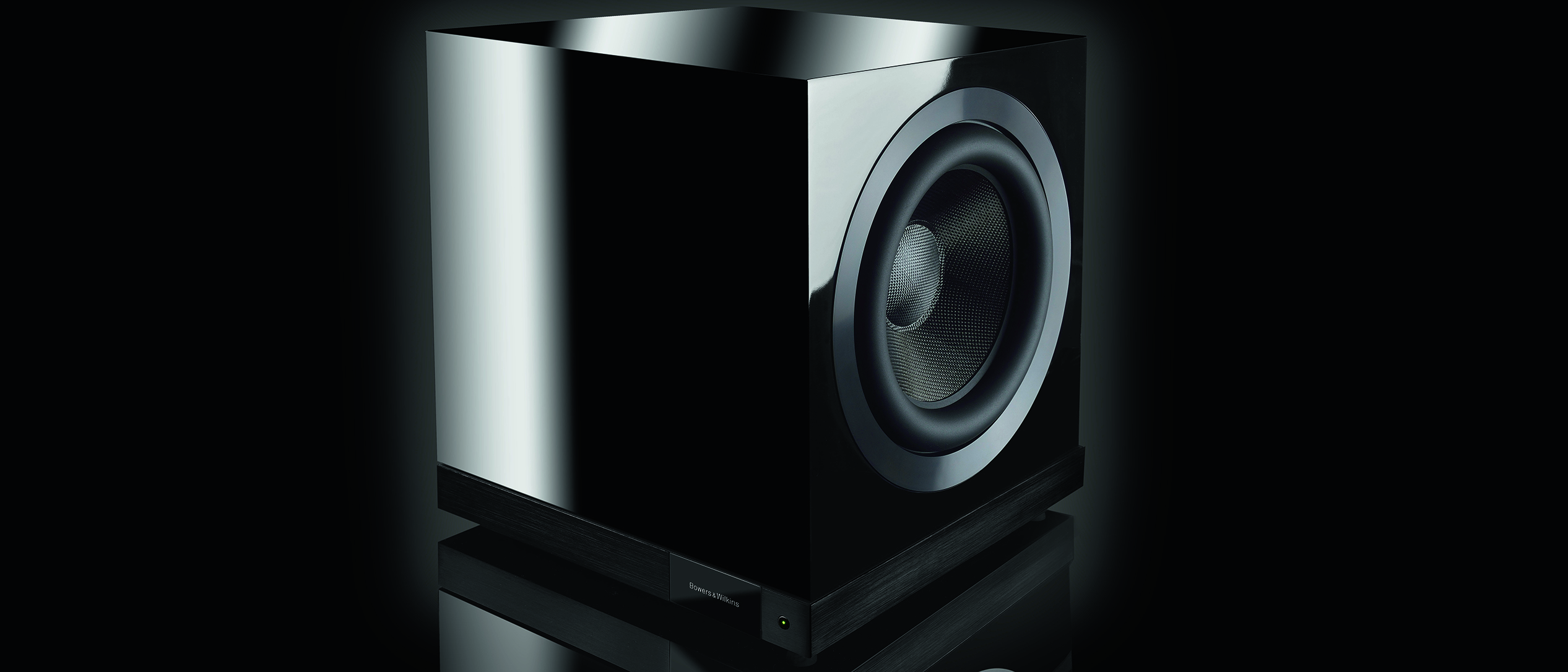What Hi-Fi? Verdict
State-of-the-art deep bass from a sensibly-sized—and very attractive—cabinet
Pros
- +
Infrasonic depth
- +
Room calibration
- +
Extensive EQ options
Cons
- -
App
Why you can trust What Hi-Fi?

This review and test originally appeared in Australian Hi-Fi magazine, one of What Hi-Fi?’s sister titles from Down Under. Click here for more information about Australian Hi-Fi, including details on how to subscribe.
Fact. The DB1D is the most powerful active subwoofer B&W has ever made. And if that fact doesn’t get your blood racing, how about that it has a low-frequency response that stretches down below 9Hz, as well as the ability to comfortably generate a sound pressure level of 92dBSPL across the pass band with negligible distortion?
Equipment
If you know something about subwoofers, you’re probably wondering how B&W manages high SPLs, low distortion and extended low-frequency performance simultaneously, since the three are usually mutually exclusive, as in if you optimise any two, you can’t expect the third.
When you see a DB1D in the flesh, and read the spec sheet, you’ll immediately know how B&W managed it. First, the cabinet is not exactly small! (It’s not exactly large, either, but it’s probably rather larger than you might have imagined.) In fact, the cabinet is exactly 460 by 429 by 410mm (HWD). Second—and you really can’t tell this from the photographs, the bass driver is a full 300mm in diameter, which is ‘way bigger than the drivers fitted to most subwoofers. Moreover, although you can only see one bass driver in most of the photographs, the B&W DB1D has TWO bass drivers (the second one also being 300mm in diameter). The Thiele/Small diameter for each cone is 250mm, which gives a total cone area of 981cm².
At this point, you’re probably thinking to yourself: ‘So what? Lots of subwoofers have two drivers.’ And if you’re thinking that, I have to tell you that you’re wrong. Although many subwoofers ‘appear’ to have two bass drivers, often only one of those two is a real driver—one with a voice coil, a magnet and all the trimmings. The other so-called ‘driver’ is actually a passive radiator, or ‘drone cone’, which does not have a voice coil, or a magnet—and sometimes not even a spider suspension. It’s just a cone. How could such a driver work? When the active driver’s cone moves ‘backwards’ into the cabinet, it compresses the air inside the cabinet, which in turn drives the cone of the passive driver outwards. When the active driver’s cone moves ‘outwards’ it rarefies the air inside the cabinet, which causes the air pressure in the room to force the passive driver’s cone back inside the cabinet. It’s this oscillating movement of the passive cone that creates sound.
Obviously, using a passive radiator is ‘way cheaper than providing a second driver but more importantly it also works completely differently, performing an entirely different function to an active driver. A passive radiator does not increase the overall sound pressure level, or the subwoofer’s power handling ability. It just provides some additional output over a very limited range of low frequencies, but in so doing, it ‘sucks’ some power from the main driver, which is then only able to deliver reduced output at those frequencies… so it’s a case of swings and roundabouts.
So why do some subwoofer manufacturers use one driven cone and one passive radiator? Frankly, one reason is that they’re hoping that many buyers will think they’re getting two drivers, and thus getting more ‘bang for their buck’.
The other reason is rather too technical to go into in the limited amount of space I have available for this review, but fitting a passive radiator means the manufacturer can make the cabinet a bit smaller than it would otherwise have to be, which makes the subwoofer a more attractive sales proposition, since most buyers prefer small subwoofers.
The latest hi-fi, home cinema and tech news, reviews, buying advice and deals, direct to your inbox.
Providing two bass drivers, as B&W has with the DB1D, means twice the power handling capability, a 3dB increase in sound pressure level, minimal cabinet vibration due to the ‘equal but opposite’ action of the cones, which effectively cancels vibrations, reduced distortion (because the voice coils operate in the most linear region of the magnetic field) and a greatly increased ‘grip’ on the air in the room, due to the increase in the cone area. To get the same cone area from a single driver would require that single cone to be 40cm in diameter.
As for the cones in the drivers in the DB1D, they’re made from a brand-new material B&W originally developed for its flagship 800 Series Diamond loudspeaker. The construction of the cone is very similar to that originally used for B&W’s ‘Rohacell’ cones, which sandwiched a foam core between two skins of woven carbon-fibre however, unlike the ‘Rohacell’ driver, whose foam core is the same thickness everywhere across the cone, the core in this new ‘Aerofoil’ cone is not constant over the cone’s diameter, but varies depending on the distance from the point at which it attaches to the voice coil former. The curve is not dissimilar to the curve of an aircraft wing, which is no doubt the reason B&W calls the new driver an ‘Aerofoil’ driver. B&W says of these aerofoil cones: ‘these light, ultra-stiff drivers resist bending and flexing far longer than conventional cones, delivering controlled bass with outstanding precision.’
If you’ve been following my description so far, you will have realised that in the DB1D, because the polarity of the cones is the same, both cones move outwards at the same time, and also inwards at the same time (a complementary motion B&W describes in its literature as being ‘balanced’.) This means that each driver is working in the opposite direction to the other, and thus working ‘against’ each other, which requires the amplifier driving them to work very hard indeed. Or it would have to work hard if it were not sufficiently powerful to be able to manage this task with ease, and since the amplifier B&W is using inside the DB1D is rated with a power output of 2,000-watts, I’d be the first to say that it was sufficiently powerful to accomplish this ‘with ease.’
To deliver this kind of power, B&W is using a Hypex Class-D amplifier designed by Bruno Putzeys, who is sometimes called the modern ‘father’ of Class-D design. (Class-D amplifiers have been around since before Putzeys was born, but he was the first to produce efficient, cost-effective designs suitable for use in consumer electronics components.) I wasn’t prepared to pry open the DB1D’s cabinet to check the type of Hypex module that’s being used, so it’s a total guess that it’s a Hypex UCD2K, and a further (and possibly even wilder) guess that it’s driven by a 3KA700 switch-mode power supply (which is also made by Hypex).
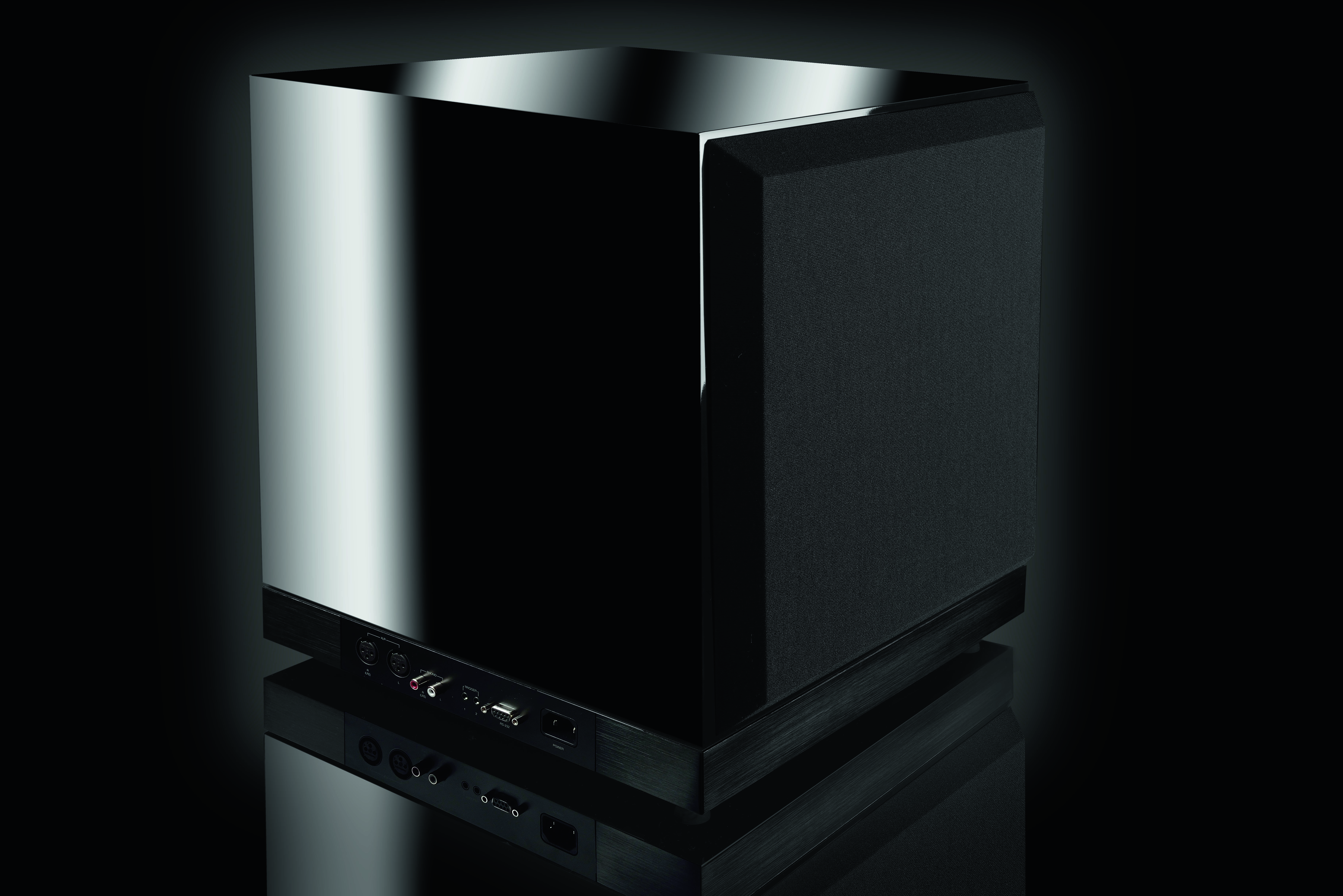
If you’ve been looking at the photos of the B&W DB1D that accompany this review you should have noticed something quite strange. It has no controls—no volume control, no crossover frequency control, no phase control… in fact none of the controls you’d usually find on a powered subwoofer. ‘Ah!’ you say, having noticed that RS-232 port, ‘it’s controlled from your computer, like B&W’s earlier DB Series subwoofers.’ Well, no, that’s not true… you cannot control the DB1D using your computer (Actually, you can, but that RS232 interface only enables the DB1D to be incorporated into a remote control home automation system).
No, the reason there are no controls (and no remote control either, for that matter) is that B&W has gone all ‘appy’ and the DB1B is now controlled via Bluetooth using a phone or tablet, with the B&W ‘DB Subwoofers’ app, available for iOS or Android, but you must be running iOS Version 10 (or later) or Android Version 5 (or later). This app gives you control over volume, crossover frequency, phase, plus the slope of the high-pass filter (12dB/octave or 24dB/octave).
But B&W’s ‘DB Subwoofers’ app does much, much more than this. By using the microphone in your device, and test tones built into the subwoofer, it can equalise the frequency response of the subwoofer to deliver a flat frequency response at your listening position, almost irrespective of where you position the subwoofer, or the size and shape of your listening room.
Once you’ve equalised the response, you can then choose to listen to the equalised response, a ‘flat’ response, or a response that you’ve tailored to suit your personal preference, using the 5-band equaliser built into the B&W DB1B.
Despite being powerful, I don’t think the app is particularly well-designed. Firstly, it’s certainly not intuitive. You’re really going to have to download the manual to get a grip on what’s going on. Perhaps my biggest issue is that it doesn’t show the choices you’re able to make. Here’s an example: When the AUTO ON display shows < Enabled > you can’t see the three choices you have for this option, which are ‘High Sensitivity’, ‘Low Sensitivity’ and ‘Disabled’. Here’s another: Where the screen shows INPUTS you can only see a choice between XLR and RCA. Hidden behind this façade are Stereo, LFE and Disabled Choices, and layered beneath these are Input Gain adjustments (–10dB to +10dB) and layered beneath these, the manual EQ functions. I also don’t think the control layering hierarchy is logical… but that could just be me. Remember though, that I didn’t have the luxury of having the DB1D’s features demonstrated to me by a hi-fi dealer in the same manner that a normal consumer would be, so I was starting from scratch. Luckily, I had B&W’s excellent Owner’s Manual in front of me to help out, in which you’ll find pictures of all of the ‘screens’ of the app, and where they’re located.
The DB1D loaned to me for this review by Bowers & Wilkins Australia was flawlessly finished in a superb piano black lacquer. Your other options are a white piano lacquer or a real wood Rosenut veneer. No matter what colour you choose, the cloth on the two grilles will be black.
Automatic room equalisation
The provision of automatic room equalisation makes the B&W DB1D far less sensitive to room placement than if the EQ were not fitted, but sensible room positioning will minimise the need for equalisation and result in better overall performance. The process for determining this is fairly simple, but the explanation of how to do it fairly lengthy, so you’d be best advised to read the article at www.tinyurl.com/subwoofer-placement which will explain how to go about it. However, when you end up with your list of suggested positions, you should disregard any where one of the two drivers in the DB1D would be close to a rear or side wall. Also, use only positions that are forward or off to one side of the listening position, not behind it. And if one or more of the suggested positions is in the same plane as the left and right speakers, prefer this position over all the others.
Once you have determined the best room position, you then use the automatic equalisation calibration system built into the DB1D which is controlled by the app. I ran into a problem here, because the calibration system didn’t work with my Android phone. This is due, according to B&W to ‘microphone incompatibilities’. A list of phones that don’t have ‘microphone incompatibilities’ can be found on B&W’s website. Luckily my better half uses an iPhone, so I loaded the DB Subwoofer app onto that and in a few more moments we were away!
B&W’s calibration system allows you to optimise the DB1D’s frequency response for the prime listening position only (the ‘sweet spot’), for a ‘couch’ (two or three listeners sitting alongside each other) or for an ‘average’ that ensures the low frequencies will be ‘averaged’ over the entire room. But the first thing you have to do is ‘calibrate’ your phone’s microphone, which you do by placing the phone very close to the cone of one of the DB1D’s two bass drivers (it doesn’t matter which one). This is a ‘near-field’ test that allows the app’s circuitry to generate a correction file to compensate for the phone microphone’s frequency response.
After then selecting your preferred calibration technique you press ‘Next’ after which the DB1D generates a series of test tones, during which you position your phone at the positions advised on your phone’s screen by the app. I was rather surprised to find these test tones were sine sweeps (repeated over and over if you’re testing multiple positions) rather than band-limited pink noise, which I would have thought was far more suitable for low-frequency testing (sine waves are particularly susceptible to room modes), but I guess B&W’s engineers know what they’re doing.
Once the calibration is complete, pressing ‘Next’ takes you to a final screen on the app which advises the frequencies at which the DB1D has applied compensation. Unlike some subwoofers where you have to use the calibrated setting, the B&W DB Subwoofer app allows you to switch between a calibrated setting and an uncalibrated one. You can also create your own ‘DIY’ frequency response by manually adjusting the DB1D’s equaliser. If you decide to do this, I would recommend putting a real-time spectrum analyser app on your phone, playing pink noise through the DB1D, then adjusting the equaliser for the flattest response. There’s plenty of room for adjustment, since the equaliser has centre frequencies at 20Hz, 28Hz, 40Hz, 56Hz and 80Hz, each one of which is adjustable over a 15dB range (–10dB to +5dB).
Of course it’s not only about matching the DB1D’s response to the acoustics of your room, you also have to match the high-frequency roll-off the subwoofer to the low-frequency roll-off of your main speakers. If your main speakers are made by B&W this will be super-easy, because the low-frequency roll-offs of all current (and quite a few older) B&W models are already pre-programmed into the DB Subwoofer app. If you’re not using B&W speakers, you have to choose the ‘Other Speaker’ setting, which then opens a dialogue that lets you choose select the low pass frequency anywhere between 25Hz and 150Hz (or Off if you’re connecting the DB1D to an LFE output), the crossover slope (12dB/octave or 24dB/octave, as noted previously) and the phase (0°, 90°, 180°, or 270°).
Listening sessions
Being by nature an experimenter, the very first thing I did after unpacking the B&W DB1D and positioning it in the optimal position in my listening room was see if it was possible, using a professional real-time analyser, a high-grade microphone and a pink noise source, as well as the manual equaliser controls built into the DB1D, to improve on the result of B&W’s own automated calibration process. Not surprisingly, I could… BUT (and I put the word ‘but’ in capitals because it’s a big but) my own calibration was for only a single position (the sweet spot) and it took me a long, long time. B&W’s calibration worked better for both ‘couch’ and ‘room’ settings.
The other part of that big BUT is that although my calibration gave a visibly flatter response on my spectrum analyser, my ‘sweet spot’ calibration was not audibly superior to B&W’s automatic calibration. I really couldn’t hear the difference between the two responses, even when switching back and forth between them… something B&W’s app lets you do. So the moral of this story is to let B&W’s automatic calibration circuitry perform its magic on the sound… don’t mess with the Zohan! If you want some personal input, you can adjust the frequency response later by choosing one of two pre-programmed settings: ‘Music’ and ‘Movie.’
The sound of the B&W DB1D is, quite simply, amazing! And I think I’ll add stunning… and magnifique… for good measure. Just for starters, it goes lower than any subwoofer of the same size I have ever heard, either in my own room or at any hi-fi show I’ve ever attended. I threw all of my finest and deepest ‘infra-bass’ recordings at the DB1D and it just turned them into powerful, accurate bass sound. It didn’t even flinch. So for good measure, I played a WAV recording I own that has tracks whose frequencies step down to 8Hz. I could hear the DB1D powering away all the way down to 12Hz… and then it was my hearing that stopped responding, not the DB1D. I knew this because at 10Hz I couldn’t hear the 10Hz sine wave, but everything in the room was rattling, so I knew the B&W was still powering away. At 8Hz the room’s walls seemed to be vibrating, and I had to turn the volume down before anything vibrated off my shelves.
But it’s not just that the B&W DB1D’s response goes lower than you’re ever going to need (or be able to hear!), no matter whether you’re using it for music, or for movies, it’s that the sound you do hear is tight and insanely realistic. Sustained pedal notes from pipe organ recordings (I can highly recommend Dorian’s recording of Jean Guillou playing Mussorgsky’s Pictures at an Exhibition and Stravinsky’s Three Dances from Petrouchka on the Town Hall organ in Zurich, Switzerland. This magnificent organ has two 32-foot pipes that allow thunderous 16Hz fundamentals, reproduced to grand effect by the DB1D. Despite the hall having been built in the 1800s—Johannes Brahms conducted his Triumphlied, Op. 55 for its opening in 1895—the organ is new, having been built by Kleuker-Steinmeyer in 1988.) If you’re not a fan of Mussorgsky or Stravinsky (and I could easily understand why you might not be), you can find many other wonderful recordings made using this organ at www.tinyurl.com/k-s-zurich. It’s worth searching one or more of these recordings out, because the venue is considered to be one of the most acoustically superb in Europe, with no less an authority on acoustics than the late, great Leo Beranek pronouncing its acoustics as being ‘excellent.’
If you’re not into organ recordings, just use the B&W DB1D to listen to any album with a well-recorded bass guitarist (or double-bassist) and drummer… in any genre from rock to jazz or anything in-between. You’ll be startled every time the kick-drum’s pedal hits the skin by the visceral impact of the punchiness of the sound of it in your room. You’ll also revel at the way you instantly hear the exact pitch of every note played on a bass guitar or double bass the second the sound waves reach your ear… no momentary puzzlement here waiting for more of the waveform to arrive! The bass depth and power is exemplified in the superb (and superbly named) track ‘I Can’t Do That, My Wife Will Kill Me’ which is the intro track on Bob Spencer’s album ‘Saints & Murderers’—an album which proves that the old rocker (think Skyhooks, The Angels, Choirboys or more recently, Rose Tattoo) is still rocking despite the cancer, and has grown a wicked and grown-up sense of humour with the passing of the years… as the track As White As Jesus (I wish that I could be as…) proves beyond any doubt. For a guitarist, Spencer seems very pre-occupied with drums, with appearances on the album by Rick McCann, Peter Heckenburg, Jacob Cook, and Peter Maslen, drummers all. Maslen’s work on Who Are These People drives the bass and the lead riffs beautifully. And you’ve got to love the lyric to Spencer’s Why Don’t You Stick To Music.
The sheer speed of the bass from the B&W DB1D is almost surreal, and means that despite being a large subwoofer, with massive cones, you can easily pair it with the smallest pair of bookshelf speakers you can find, and the transition will still be seamless. Usually, big-coned subwoofers work best with big-coned floorstanding speakers. The DB1D is obviously the exception that proves the rule. However, if you do own a pair of large floorstanding speakers, the B&W DB1D will improve and extend the bass you’re currently getting… and I don’t care how low your main speakers go, the B&W DB1D goes lower. Guaranteed. It’ll also go louder. Louder than you’ll ever need. Guaranteed.
Verdict
Famous though B&W is, the company is not renowned as a manufacturer of high-end subwoofers… and that’s despite the DB1D’s predecessor (the DB1) being a fixture in Stereophile magazine’s ‘Class A’ product listing. The appearance of the DB1D shows that B&W has decided to pull out all the design (and engineering) stops to change all that. If you want state-of-the-art deep bass from a sensibly-sized—and very attractive—cabinet, buy the B&W DB1D: It’s a truly superb-sounding and fully-featured subwoofer.
Laboratory test report
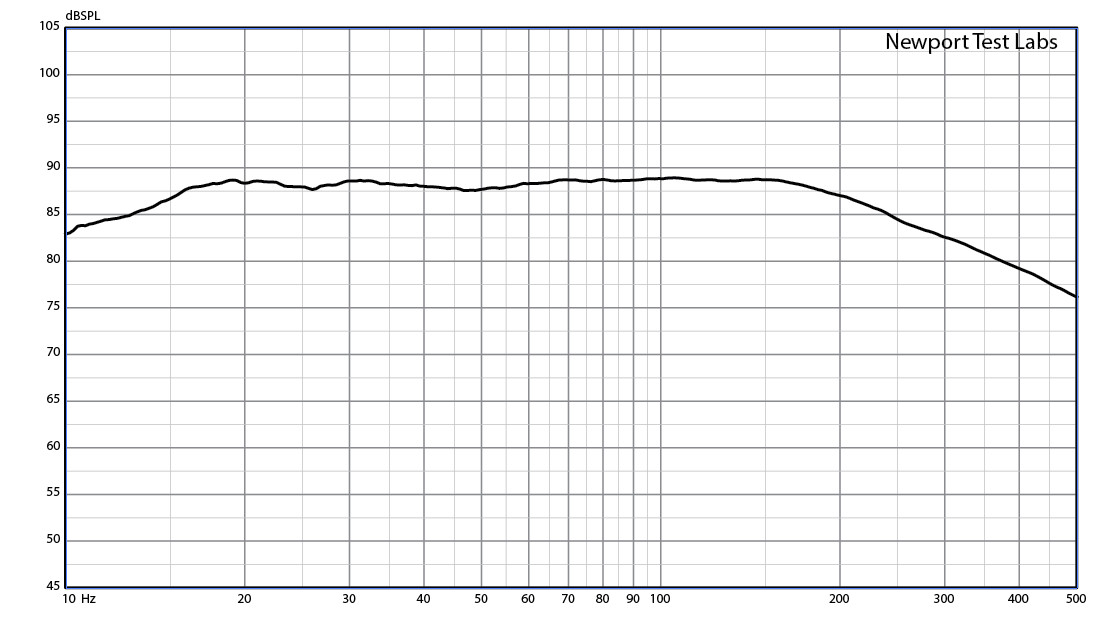
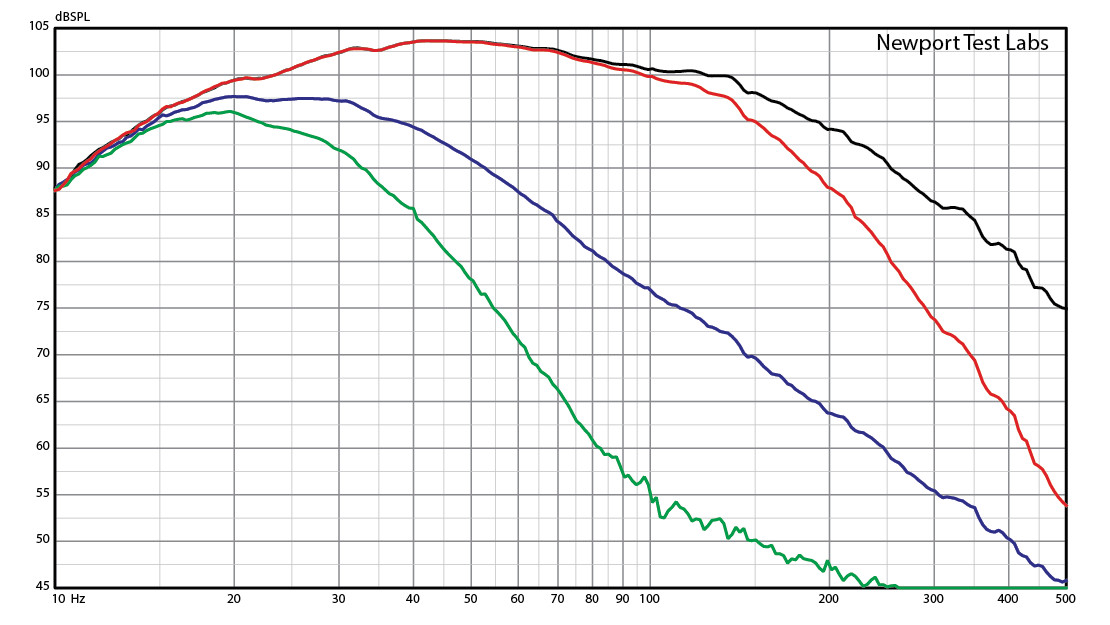

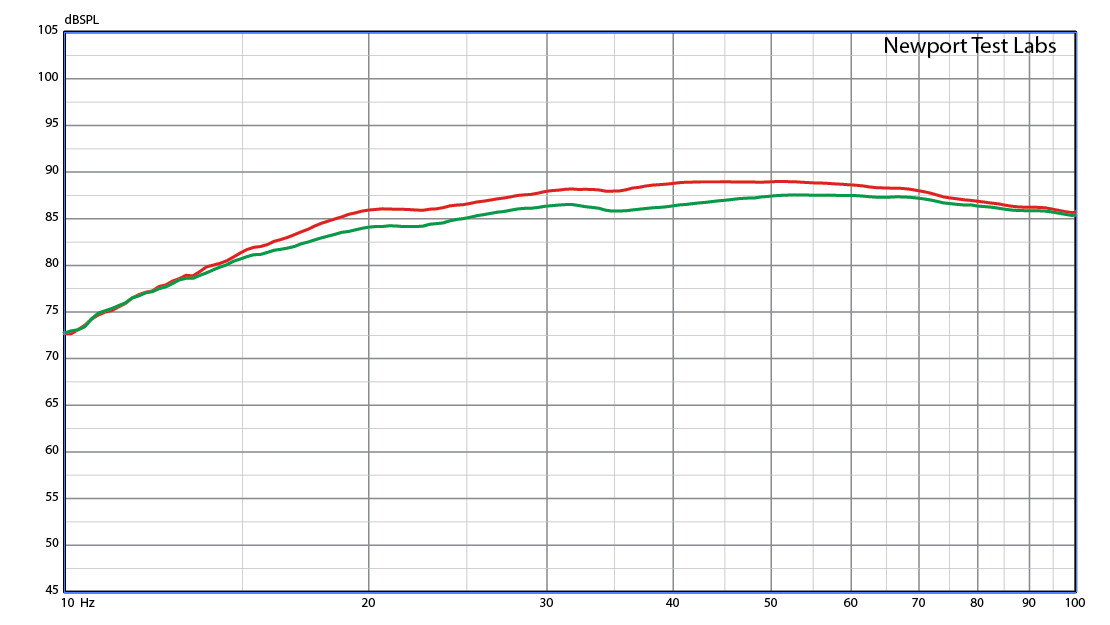
Newport Test Labs measured the frequency response of the B&W DB1D after calibration, and with the low-pass filter set to 150Hz plus a 12dB/octave filter slope, the result of which is shown in Graph 1.
You can see that the response is amazingly flat across the pass-band, essentially measuring from 15Hz to 200Hz ±1dB. I don’t think I’ve ever seen a subwoofer with such a flat response. I also don’t think I’ve seen a subwoofer with such an extended low-frequency response. You can see the output of the B&W DB1D is only 3dB down at 10Hz. Note, too, that 10Hz is the graphing limit… the B&W’s DB1D’s response extends further downwards, so that it’s –6dB at 8.5Hz. The overall normalised frequency response measured by Newport Test Labs for the B&W DB1D was 10Hz to 240Hz ±3dB… and that’s with the low-pass filter on, which is effectively limiting the high-frequency response. The response with the filter switched off (not shown) is 3dB down at 350Hz and 6dB down at 520Hz.
Graph 2 shows the ‘raw’ un-calibrated near-field frequency response of the B&W DB1D showing the effect on the response when the low-pass filter is set to 15Hz and also to 150Hz for both the 12dB/octave and 24dB/octave settings. You can see that for the 150Hz (12dB/octave) setting, peak output from the drivers is at 45Hz and the response is still remarkably flat even without equalisation, extending from around 17Hz to 150Hz ±3dB. For the 15Hz (12dB/octave) setting of the controls, the response extends from 12Hz to 50Hz ±3dB, which is again excellent. The fact that the responses are so flat without equalisation means that only minimal equalisation needs to be applied to correct the response, so B&W’s equalisation is better-able to correct for your room’s acoustics.
The final graph (Graph 3) shows the difference in the frequency response between the movie (green trace) and music (red trace) equalisation settings. You can see the differences are only between 15Hz and 100Hz and are fairly minor, with the maximum difference occurring at 40Hz, where the music trace is boosted 3dB above the movie trace.
The B&W DB1D returned outstanding measured performance in Newport Test Labs’ tests, delivering an amazingly flat and extended frequency response.
Australian Hi-Fi is one of What Hi-Fi?’s sister titles from Down Under and Australia’s longest-running and most successful hi-fi magazines, having been in continuous publication since 1969. Now edited by What Hi-Fi?'s Becky Roberts, every issue is packed with authoritative reviews of hi-fi equipment ranging from portables to state-of-the-art audiophile systems (and everything in between), information on new product launches, and ‘how-to’ articles to help you get the best quality sound for your home.
Click here for more information about Australian Hi-Fi, including links to buy individual digital editions and details on how best to subscribe.
